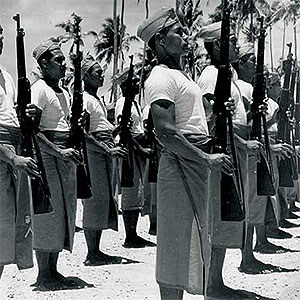United States and Samoa

NPS
In 1872, Commander Richard W. Meade, USN, arranged a treaty with the principal chief on Tutuila, the Mauga, allowing the United States the exclusive right to develop a naval station at Pago Pago, but the United States Senate, going through one of its more isolationist phases, refused to ratify the agreement. The islanders, however, apparently considered the agreement binding and cooperated with Meade when he drew up a list of commercial regulations for the port of Pago Pago. The Samoans, perhaps feeling a bit isolated and vulnerable as they saw more and more foreign ships in their waters, continued to seek protective alliances with both the United States and Britain. In 1878, the United States Senate ratified a treaty giving the United States the right to establish a naval station at Pago Pago, but passed on the opportunity to annex the islands. Included in the provisions of the treaty of 1878 was the right to maintain a coaling station on Tutuila. For a significant amount of ten dollars per month, the United States Navy rented a tract of land at the village of Fagatogo, on the southern shore of Pago Pago Bay. At this time the nearest United States government representative was the American Consul at Apia, on the island of Upolu.
Through the final two decades of the nineteenth century, tensions rose and fell between the Americans and the British in the area on the one hand and the expanding interests of Germany on the other, culminating in 1899 in a series of small but fatal clashes between the chaotic Samoan government, possibly inspired by German assistance, and the Americans and British. The resulting negotiations between the United States, Great Britain and Germany, signed on 14 November 1899, assigned Tutuila and the other islands east of the 171st meridian to the United States and the western islands in Germany, the latter having traded concessions in other parts of the South Pacific to Britain in return for control of Western Samoa.
In 1889, the United States Navy had decided to take a serious look in constructing an actual naval station at Pago Pago. Rear Admiral Lewis A. Kimberly traveled to Tutuila to choose a site, recommending an area east of Fagatogo. Due to delays in land purchases, actual construction of the naval station didn’t begin until 1898. A Presidential Executive Order issued on February 19, 1900 placed American Samoa under the jurisdiction of the Navy Department. On the same day the Secretary of the Navy issued an order establishing the islands as a naval station under the control of a commandant. The first commandant of the Naval Station, who had arrived in August 1889, was Commander Benjamin F. Tilley. Tilley was for all practical purposes the first governor of American Samoa. He also arranged the formal Deeds of Cession to the United States of Tutuila (April 1900) and Manu’a (1904). Tui Manu’a the king of Manu’a still wanted to run his own island and claimed his government had no affiliation with the island of Tutuila. Although he did not signed the Deed of Session in 1900 but the flag was still raised in Ta’u. It wasn’t until king Tui Manu’a and his chiefs, being content and satisfied with the justice, fairness, and the wisdom of the United States that he signed the Deed of Session in 1904.
World War II
As World War II began, the Samoa islands were an essential link in the chain of communications between the United States, Australia, and New Zealand, a sea lane that also ran through the Fiji island. Holding the line drawn from Midway to Samoa, Fiji, and Brisbane against the Japanese was considered essential. The loss of these islands would have effectively cut off communications between the west coast of the United States and Australia. The Samoa islands played an important role by protecting these trade routes and to safeguard communication links to the south.
With the Pearl Harbor attack, the governor/commandant assumed direct control of all construction work in progress on Tutuila and rechanneled the efforts into defense of Pago Pago Harbor and the immediate vicinity, particularly bombproof shelters. American Samoa was touched by enemy fire only once. On January 11, 1942, the Naval Station was shelled by a Japanese submarine. One shell, an odd stroke of irony, struck the home and store of one of the very few Japanese residents of the island. Another struck the Navy Dispensary, doing only minor damage, but most of the shells landed in the bay. At the time, of course, the incident must have seemed to be only the beginning. This was the only enemy attack in American Samoa.
On January 20, 1942, the Marine Brigade arrived with 5,600 officers and enlisted men with their heavy artillery to defend the island. Natives were also recruited to form a Samoan Marine Brigade known as (Maligi Samoa) that consisted of 350 men. Tutuila island became the largest jungle training center in the South Pacific. The Battle of the Coral Sea in the Pacific was the turning point of the war, when the Japanese lost so many of their men and war ships by the Americans.
Orders were given to begin the dismantling of the war effort in the Samoa Group in February 1944. By the summer of 1945 the Naval Station had reverted to its peacetime status as a permanent base. Its purpose as such included limited anchorage facilities, a fueling station, a minor repair depot, supply and communication facilities, and a weather station.
Last updated: April 23, 2020
